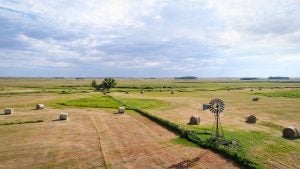My family farms just over 2,000 acres in Southwest Michigan. Most of that land is rented, with a only a few hundred actually owned by our family. We generally have relationships with most landlords spanning a generation. And those individuals trust us to use best practices while we farm their land (I even include that as a term of our lease agreements).
But farm landlords aren’t always painted in such rosy colors. In fact, there’s a pervasive idea that non-farming landowners are barriers to the widespread adoption of conservation production methods. It’s based on the idea that landlords only own the land for investment purposes — so they value profit over sustainability. And farmers owning that land don’t care about long-term sustainability — instead they want only to push limits on yields to maximize profits.
We now have data from U.S. Department of Agriculture that sheds a light on these landlords and their relationship to the land. Nearly 268 million acres of farmland — or three in every 10 — is rented out by an owner who doesn’t actively farm. But distance between the landlord and the farm is heavily skewed in favor of shorter distances. About 185 million acres — or 67 percent — is owned by landlords who live within 50 miles of the rented land.
Significantly, there was no statistical association between the percentage of absent landlords and the percentage of acres employing minimum-tillage practices in 2017. So the mythical absentee landlord doesn’t seem to be a realistic barrier to conservation.
The USDA’s findings reflect the reality I know from experience. Many of our landlords purchased land to build a home and raise a family decades ago. They weren’t farmers, but they lived on the land. And they rented the acres to nearby farmers for some extra income.
So these land owners aren’t big-city slicks buying up farmland as an investment. They aren’t some faceless hedge fund trying to squeeze the farm’s value out before they sell and invest elsewhere. Landlords are our neighbors and family friends. They live on the land and see how we manage it. And we wouldn’t ruin decades-long relationships just to pilfer a couple extra dollars from the soil. Nor would we farm very long if we didn’t have an eye for the long game.

The survey revealed an interesting caveat. In 2014, areas with lower farmland rental rates, lower land values, lower income growth, and lower employment growth had a higher percentage of absent landlords. That makes some sense. Those areas likely suffered the most economic losses that can result in farmland going for sale. And investors may find these areas easier for entry-level purchases.
Congress mandated the USDA to study so-called absentee ownership in the 2018 Farm Bill. The Economic Research Service collected the data from surveys of land tenure and transfer. And while the data is illuminating, the ERS admitted there’s room for a lot more research.
The data also shows that, unsurprisingly, landlord distances vary by state. For example, in North Dakota landowners live 420 miles from their property on average. But in Pennsylvania landlords are usually less than 15 miles away. So local history and trends have a lot to do with how land is farmed.
The USDA’s report is obviously a first step in collecting and understanding more about agriculture landlords. But I’m confident that continued study will continue to show that these relationships don’t hinder conservation production methods. Instead they create rich rural communities that have everyone invested in sustainability.
Amanda Zaluckyj blogs under the name The Farmer’s Daughter USA. Her goal is to promote farmers and tackle the misinformation swirling around the U.S. food industry.



